سوسک باقلا
| Bruchus rufimanus Boheman | ||
 |
Common Name | |
| broadbean weevil | ||
 | ||
| Exotic | ||
| Phylum: | ARTHROPODA | |
| Class: | HEXAPODA | |
| Order: | Coleoptera | |
| Photo © Bayer AG |
Family: | Chrysomelidae |
| Notes: | ||
|
732 of 4320 | ||
 |
Bruchus rufimanus Boheman (Coleoptera, Bruchidae, Bruchinae) La plus grande espèce du genre Bruchus de la région (4-5 mm). Pronotum peu transverse. Pattes intermédiaires noires. Tibias du mâle un peu tordus, munis d’une gouttière longitudinale et terminés par une petite épine aigüe. Pubescence du dessous dense et forte.
|
| < retour à la liste |
سوسک نخود فرنگی Bruchus pisorum

(Coleoptera, Bruchidae, Bruchinae)

سوسک برزیلی Zabrotes subfasciatus

Mexican Bean Weevil
Zabrotes subfasciatus (Boheman) (Coleoptera: Bruchidae: Amblycerinae)

سوسک لوبیا Acanthoscelides obtectus
 |
Acanthoscelides obtectus (Say) (Acanthoscelides obsoletus (Say)) (Coleoptera, Bruchidae, Bruchinae) Cuisses postérieures munies, à la face inférieure près du genou, de trois denticules, un grand et deux plus petits. Pubescence fournie, voilant le fond, brun-roussâtre, formant sur les élytres de vagues bandes transversales plus sombres. Plantes-hôtes : divers Phaseolus (Haricots). Se développe sur les plantes dans les cultures ou dans les graines sèches stockées.
|
 |
 |


پروانه موم خوار زنبور عسل Galleria melonella

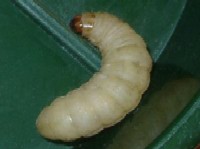

بید لباس Tineola biseliella

- Détruit lainages, fourrures, peaux, plumes et animaux empaillés, brosses, semoule, caséine, etc.
Larve : 10 mm, presque cylindrique ; tête brun clair, corps blanchâtre avec une raie longitudinale brun pâle.
Adulte : 12 à 16 mm d'envergure ; tête rougeâtre, corps jaune paille ; ailes antérieures d'un jaune beige uniforme satiné, les postérieures d'un blanc grisâtre satiné et frangées.
Les œufs sont déposés en petits groupes ou isolément, la durée de l'incubation est de 1 à 3 semaines. La durée totale du cycle de développement varie de 2 à 3 mois, il n'y a généralement que 2 générations par an.

لمبه گندم

افت درجه یک گندم کنترل با آمبوش و پرمترین
|
Khapra beetle | ||
|
Trogoderma granarium
| ||
|
|
| |
Life cycle The female lays up to 125 eggs loosely in the infested material. Eggs hatch in five to seven days. Larval development may occur in four weeks, but under cooler temperatures, over crowding, poor food quality, or declining conditions, the larvae may enter a dormancy phase known as diapause. They can remain in this state for up to three years. The larvae undergo 4 - 7 molts, resulting in the shedding of numerous cast skins. Adults are short-lived, completing their adult life in one to two weeks. Mating occurs almost immediately after adult emergence, with oviposition for one to six days following. In ideal conditions the life cycle can be completed in as few as 30 days. | ||
Damage The khapra beetle is considered to be the world's most destructive pest of stored grain and grain products. If left uncontrolled, this beetle can cover the surface of stored grain making it appear alive with crawling larvae. It is also considered to be a dirty feeder as it breaks or powders more grain than it consumes. They also contaminate the grain with larval skins and setae which have been known to cause gastrointestinal irritation. The beetles probably originated in India and Bangladesh, but have since spread to northern and eastern Africa, southern Europe, the Mediterranean region, the Mideast and Asia. A symptom of infestations is the presence of cast skins throughout the infested material. It is frequently intercepted on obvious food products such as rice, peanuts, dried animal skins, as well as its preferred natural foods such as wheat and malted barley. Such infestations may result from the storage of the product in infested warehouses, by transportation in infested conveyances, or from re-use of sacks or packaging previously used to hold material infested by khapra beetle. They have also been found in automobiles, steel wire, books, boxes, bags of bolts, linen and oil paintings. | ||
Control Fumigation is the most effective form of treatment of khapra beetle infestations. Methyl bromide or phosphine is usually the treatment of choice. Because of khapra beetle's habit of hiding in every concievable crack and crevice, the entire storage facility and its contents must be fumigated. Typically, the building is covered by tarpaulin and the fumigant is pumped in at an approved rate. | ||
سوسک کشکDermestes maculatus


انتهای بالپوش خار دارد
سوسک چرم Dermestes frischi
Cryptolestes sp.
سوسک میوه خوار
São conhecidas mais de 2.000 espécies desta família. A maioria se alimentam de seiva das árvores e do suco de frutas. Carpophilus e Urophorus são as espécies mais freqüentemente encontradas nos armazéns. Sobrevivem sobre grãos de cereais armazenados em regiões úmidas, especialmente nos trópicos, e são comumente encontradas sobre milho armazenado para subsistência do produtor. C. dimidiatus (F.) é cosmopolita sobre cereais, sementes oleaginosas, cacau, noz e diversos outros produtos. C. pilosellus Motschulsky é freqüentemente encontrada em farinha-de-arroz. Outras espécies detectadas em produtos armazenados são C. freemani Dob-son, C. fumatus Boheman, C. maculatus Murray, e C. obsoletus Erichson. No gênero Urophorus, U. humeralis (F.) tem sido registrado sobre milho avariado, tâmara e frutas secas nas regiões tropicais e subtropicais. É um inseto conhecido como importante praga da cultura do abacaxi.

Carpophilus dimidiatus (Fabricius)
(Fonte: www.ento.csiro.au/aicn/ name_s/b_637.htm)

Carpophilus dimidiatus

شپشه ذرت

Sitophilus zeamays
فرورفتگیهای روی پرونوتوم بیضی شکل و دارای لکه های روشن روی بالپوش می باشد.
شپشه برنج
Sitophilus oryzae
|
|
 |

|
Rice Weevil | |||
|
Sitophilus oryzae
| |||
|
|
| ||
Life cycle The egg, larva, and pupa stages of these weevils occur in the grain kernels and are rarely seen. Feeding is done within the grain kernel, and adults cut exit holes to emerge. Emergence holes of the rice weevil are smaller than those of the granary weevil, and tend to be smooth and round. Females drill a tiny hole in the grain kernel, deposit an egg in the cavity, then plug the hole with a gelatinous secretion. The egg hatches into a young larva which bores toward the center of the kernel, feeds, grows, and pupates there. New adults bore emergence holes from the inside, then leave to mate and begin a new generation. Female rice weevils lay between 300 to 400 eggs, with the life cycle requiring about 32 days for completion. The adults live 3 to 6 months, infesting grain in the field. Two larvae can develop in one wheat kernel. The adults can feign death by drawing up their legs close to the body, falling, and remaining silent when disturbed. | |||
Damage Rice weevils are pests of stored grain and seeds. They develop inside whole grain kernels as small, white, wrinkled, grub-like larvae. There is generally no external evidence that the larvae have been eating and growing inside the seed until after about one month when the adult weevil chews through the seed coat and emerges. Rice and granary weevils are harmless to people, houses, furniture, clothing and pets. They cannot bite or sting and they do not carry diseases. They will not feed on furniture, the house structure or other items. The harm they do is destruction of the seeds they infest. | |||
Control The simplest and most effective measure is to locate the source of infestation and quickly get rid of it. If practical and regulations allow, dispose of heavily infested foods in wrapped, heavy plastic bags or in sealed containers for garbage removal, or bury deep in the soil. If you detect an infestation early, disposal alone may solve the problem. Properly ventilate the storage area to discourage these moisture-loving stored product pests. Be sure to store only clean, dry grain with a moisture content of 12 percent or less to reduce weevil problems. Grain insects are declared under the Agriculture and Related Resources Protection Act. Limited chemical controls are available to farmers and emphasis is placed on clean hygienic storage and cleaning of machinery. Farmers are encouraged to purchase and maintain sealed farm silos to increase the effectiveness of fumigation.
| |||
|
|
|||
.
شپشه استرالیایی
|
Rhizoperta dominica -( Ord. Coleotteri – Fam. Bostrichidi (Cappuccino dei cereali) | |||
|---|---|---|---|
|
|
Gli insetti di colore bruno scuro sono lunghi 2,5-3 mm e possono volare. La testa è nascosta sotto il protorace arrotondato; le antenne, terminanti in tre protuberanze tarchiate, sono visibili. La larva appena formata è biancastra con la testa gialla; il dorso è inizialmente ricurvo, ma dopo il quarto segmento curva decisamente verso l'interno.
| ||
سوسک نان

استری های روی بدن شبیه عدد ۷ شده اند.
سر باشلق مانند
پشت لارو حاوی خارهای ردیفی
آفت مهم کاغذ و کتاب و جلدهای چرمی
تغذیه لارو از چربیها
|
Drugstore beetle | |||
|
Stegobium paniceum
| |||
|
|
| ||
|
|
Life cycle The adult beetles live from 2 to 4 weeks and during this time the females may deposit between 20-100 eggs. The hatching larvae are .5 mm long and very mobile. The larval period usually ranges from four to five months, but under favorable conditions the development from egg to adult may occur in 6 to 8 weeks. When the larvae are fully grown, pupation occurs and they remain in this resting stage for 12 to 18 days. | ||
Damage The drugstore beetle gained its name because it was frequently found feeding on drugs in pharmacies many years ago. Now, they are customarily found infesting all types of dry stored food products, spices, seeds, grains and dried plant material. They have also been known to feed on leather, wool, hair and books. The infested item will contain 3 - 4 mm long, red-brown, oval beetles and small, white larvae. Adult beetles often wander away from infested materials and may be found throughout the area. Their presence can be detected from pinhead holes in the infested items. Packaging materials such as paper and cardboard are also attacked. Since the drugstore beetle can fly well, the source of infestation can sometimes be hard to find. The drugstore beetle is not a major pest in stored grains. | |||
Control Control requires locating and eliminating/treating the infested material. All potentially infested materials should be carefully examined. | |||
.
سوسک عنکبوتی سیاه

|
Smooth spider beetle | ||
|
Gibbium psylloides
| ||
|
|
| |
Life cycle The female smooth spider beetle lays 50 - 100 eggs loosely among the infested goods. The larvae can spin and therefore pupate inside a cocoon. Hibernation can take place at any time during development and the adults can survive for up to 1 and a half years. In optimum conditions (33 �C) the life cycle can be completed in as few as 45 days. | ||
Damage Smooth spider beetle larvae will infest all manner of dry animal and vegetable matter including broken grain or grain products, seeds, dried fruits or meats, wool, hair, feathers, rat and mouse droppings, insect and other animal remains, plant and animal museum specimens, books, dried mushrooms, animal feeds and sugar. The larvae bore holes in which to pupate, and in so doing may damage packaging or the commodities themselves. They also contaminate commodities with droppings and silk webbing. Adult beetles will also damage packaging including bags and sacks. Gregarious and nocturnal, they spend the day in cracks and crevices. | ||
سوسک عنکبوتی زرد
| Messingkäfer | ||||||||||||
|---|---|---|---|---|---|---|---|---|---|---|---|---|
| Systematik | ||||||||||||
| ||||||||||||
| Wissenschaftlicher Name | ||||||||||||
| Niptus hololeucus | ||||||||||||
| (Faldermann, 1836) |
| |||||
| Niptus hololeucus | Niptus hololeucus | ||||

سوسک سیاه آرد

Tenebrio obscurus
بدون شیار در پرونوتوم (بر خلاف سوسک زرد آرد)
تا ۲ نسل در سال می دهد.
از آفات درجه ۲ غلات

سوسک سیاه قارچ خوار
 | |||||||||||||
| Taxonomische indeling | |||||||||||||
|---|---|---|---|---|---|---|---|---|---|---|---|---|---|
| |||||||||||||
| Soort | |||||||||||||
| Alphitobius laevigatus Fabricius, 1758 |
Tenebrionidae خانواده
پاها به رنگ قرمز می باشد.
لاروها به رنگ سفیداست و دارای یوروگامفی می باشد.
از آفات ذخیره پیله کرم ابریشم است.
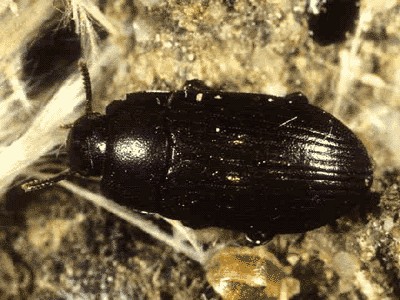
سوسک کدل
سوسک شاخک کوتاه آرد
|
Family Tenebrionidae
درجه ۲ غلات عرض پرونوتوم در عقب کمتر از جلو رژیم اول گوشتخواری بوده و بعد به گیاهخواری رو آورده است. |
 |

Necrobia rufipes . سوسک گوشت
Volgograd reg.
Pallasovka distr.
N Elton lake
15.V.2006
leg. A.V. Matalin
Body length 6.5 mm
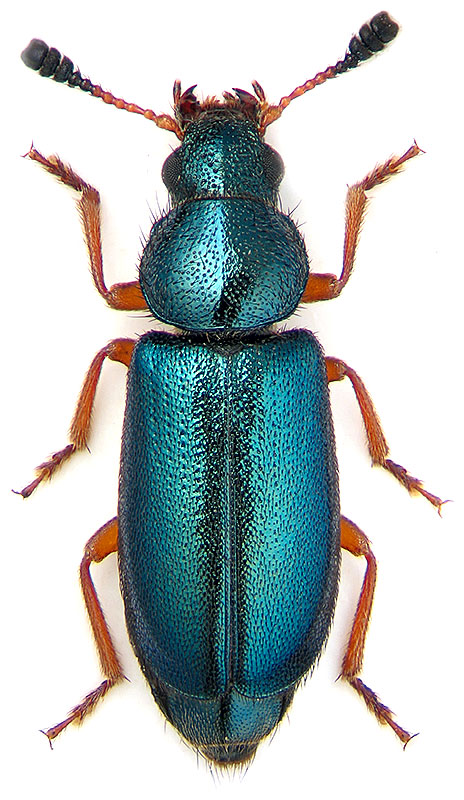
پاها به رنگ قرمز
لارو قرمز رنگ
تغذیه از لارو مگس پنیر
تغذیه لارو از عمق مواد غذایی
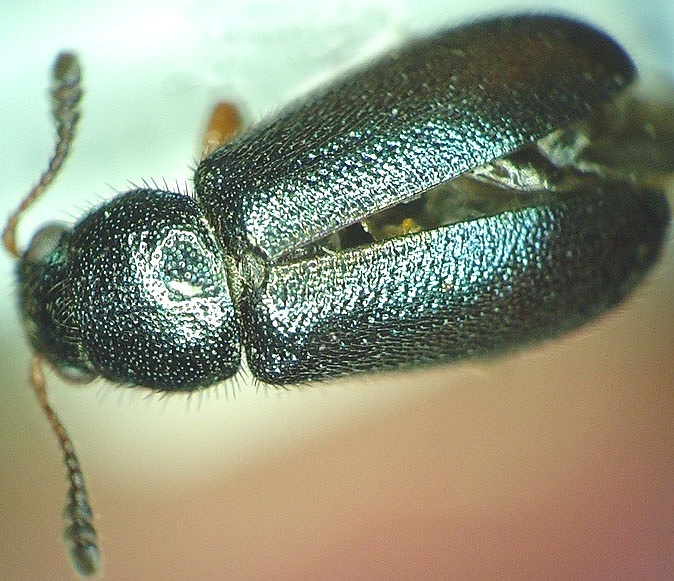
شپشه دندانه دار
oryzaphilus surinamensis
خانواده :Cucujidae
تخمريزي به صورت انفرادي يا گروهي ميان مواد غذايي
تعداد نسل در سال :3-8 نسل




Lasioderma serricorne (Fabricius) سوسک توتون

خسارت سوسک توتون روی سیگار
خانواده آنوبیئیده
در این خانواده حشرات کامل بدون تغذیه بوده و خسارت اصلی مربوط به لاروهاست.

شپشه ي گندم
نام علمي : Sitophilus granarius
خانواده: Curculionidae

زمستانگذراني : حشره ي کامل
تخمريزي : انفرادي داخل دانه
اندام مورد حمله : دانه غلات ، آرد ، نشاسته و سبوس
نسل در سال : 3 تا 5 نسل
بند پنجه: 5 بندي مخفي
نام انگليسي : Grain weevil
شپشه برنج

شپشه برنجOryzae sitophilus
حشره کامل سرخرطومی کوچکی به نگ قهوه ای است و روی پیش گرده از فرورفتگی های گرد پوشیده شده است. رنگ عمومی بال پوش ها قهوه ای تیره و روی هر بال پوش ها دو لکه بزرگ به نگ قهوه ای روشن دیده می شود. خرطوم نرها نسبت به ماده ها ضخیم تر است و هم کوتاه تر است.
خسارت عمده حشره در درجه اول مربوط به لارو است . طول عمر حشره کامل به طور متوسط 4 تا 5 ماه است و تعداد تخم های گذاشته شده 400 تا 576 عدد می باشد.
برای مبارزه برای ضدعفونی انبار های خالی می توان از تکیبات فسفره مثل اکتلیک به میزان 1 تا 2 گم ماده موثره برای هر متر مربع به صورت محلول پاشی استفاده کرد
استفاده از قرص های حاوی فسفات آلومنیم و منیزیم به میزان 5-6 قرص به ازا هر تن محصول یا 1-2 قرص به ازا هر مترمکعب فضای باز
شبپره هندی Plodia interpunctella

شب پره هندی در تمام دنیا و ایران بخصوص در نواحی جنوبی در انبارهای خرما و در قزوین در انبار های پسته و در تهران در انبارهای بادام شیوع دارد .
پروانه مزبور یکی از آفات انباری روی خشکبار ، غلات ، بذور ، حشرات خشک شده و کندوی عسل می باشد و تا کنون حدود 83 نوع ماده غذای نام برده شده که مورد تغذیه لارو این حشره قرار می گیرد .
حشره کامل شب پره ای است به طول 8 میلیمتر و عرض آن با بالهای باز 16 تا 20 میلی متر است . یک سوم بالهای جلوی از جهت از جهت قاعده به رنگ خاکستری روشن و دو سوم بقیه به رنگ قهوه ای متمایل به قرمز است .
در موقع استراحت بالها در اطراف بدن تا می شود و یک سوم بالایی آنها به شکل لکه خاکستری رنگ به نظر می رسد . و شاخک در این موقع در روی بالها تا شده است . بالهای زیری خاکستری یک دست مایل به زرد است و ریشکهای کناره آن زیاد طویل نیست .
لارو جوان به طول 1 میلیمتر و لارو کامل به طول 14 تا 17 میلیمتر به رنگ سفید کثیف و یا صورتی کمرنگ است . سر و پشت سینه اول و پاهای اصلی به رنگ زرد مایل به قهوه ای و تمام حلقه های بدن دارای موهای بلندی است و پاهای شکمی دارای قلابهایی می باشد .
اندازه تخمها بین 0.1 تا 3.5 میباشد . اغلب حشرات بالغ تغذیه نمی کنند و به طور متوسط 7 روز زندگی میکنند . اگر حشره ماده از شهد گلها تغذیه کند میتواند تا 14 روز زندگی کند و تا 1100 تخم بگذارد .
هر چرخه زندگی بین 18 تا 60 روز طول میکشد ، 2 تا 8 نسل در سال می تواند داشته باشد . یک ماده بالقوه می تواند در كمتر از دو ماه 6750000 لارو تولید کند . حل تصور بکنی تغذیه اینها را اگر همه زنده بمانند .
لاروا خورنده های توانمندی می باشند . مرحله لاروی د ر دمای 30 درجه سانتی گراد 6 روز می تواند باشد اما در درجات پایین تر تا 28 روز طول میکشد .
بعد از پیدایش ماده ها فرمونی ترشح میکنند که باعث جدب نرها می گردد . این فرمن مهم ترین عامل در نظارت یا دیدبانی برای این حشره است .
فرمن (Z, E)-9, 12-Tetradecadien-1-ol acetate) به طور مصنوعی ساخته شده است و وسیله ای برای نظارت بر مذکرها میباشد
حشرات کامل سه روز پس از پدیدار شدن جفت گیری میکنند و شبپره ماده از 40 تا 500 عدد تخم و به طور متوسط 150 عدد تخم به طور منفرد یا در دسته های 11 تا 30 عددی روی مواد خوراکی میگذارد .در شرایط مناسب تخمها پس از سه روز تفریخ می شوند و در محیطهای نا مناسب ممکن است 15 روز بعد تفریخ شوند .
این حشره فعالیت شبانه دارد و روزها را روی مواد غذایی و دیوارهای انبار بدون فعالیت میگذراند . طول دوره لاروی بر حسب درجه حرارت محیط و نوع غذا تغییر میکند و در شرایط مناسب 25 تا 30 روز است . اغلب دیده شده است که نشو و نمای لاروهای شبپره هندی از نظم معینی خارج نمی شود .
شبپره هندی روی گندم، رطوبت نسبی 5 + - 70 درصد و دمای 30 درجه سانتیگراد بهترین رشد و نمو را دارد و طول دوره زیستی آن کوتاه می شود .
لاروهاي شبپره هندي روي ماده غذايي گندم رشد بيشتري دارند و براي اطمينان بيشتر از اين نتيجه، يک تجزيه شيميايي کامل از ترکيبات موجود در سه نوع ماده غذايي انجام شد و معلوم گرديد که مقدار بسياري از اين ترکيبات در گندم نسبت به خرما و ذرت بيشتر است .
لاروهایی که همزمان از تخم خارج می شوند با وجود اینکه از لحاظ موقعیت محیط زیست و نوع تغذیه در شرایط کاملا برابر قرار می گیرند هر یک از رشد و نمو مشخص به خود دارد به طوری که در مدت 2 ماه بعضی به سن دوم ، برخی به سن سوم و گروهی به سن جهارم میرسند . پس از این مدت لارو پیله ابریشمی نازک تشکیل میشود و در آن شفیره می شود و پس از چهار روز تا چهار هفته حشره کامل خارج می شود . به این ترتیب این حشره در شرایت مناسب می تواند در مدت 40 روز تکامل خود را به پایان برساند و در سال 2 تا 5 نسل داشته باشد . نگه داری مواد داخل ظروف دربسته در کنترل آفت موثر است .
استفاده از قرص فستوکسین تجویز در ضمن زنبور Bracon hebetor پارازیت لاروها می باشد که ابتدا لاروها را بیحس کرده و بعد تخمریزی می کند بطوری که خسارت شدیدی به لاروها وارد می کند .
براي امکان کنترل شبپره هندي توسط باکتري B.t، از فرمولاسيونهاي تجارتي با نامهاي Bactospine, Thuricide, Dipel استفاده شد. در اين بخش از تحقيق، هشت غلظت مختلف از هر سوش باکتري تهيه گرديد و مقدار 500 گرم از هر نوع ماده غذايي بطور جداگانه توسط غلظتهاي مختلف تهيه شده آلوده گرديد و سپس به تعداد مساوي از سنين مختلف لاروهاي شبپره هندي، روي هر يک از مواد غذايي آلوده قرار داده شد. پس از آن با نمونهبرداري هر 24 ساعت يک بار، تعداد لاروهاي مرده شمارش گرديد و در جداول خاص خود يادداشت شد و نهايتا LC50 مربوط به هر فرمولاسيون، نسبت به هر يک از سنين لاروي مشخص گرديد.
نتيجه کلي اين بخش نشان داد که بهترين سوش براي کنترل شبپره هندي، سوش Dipel است ، زيرا مقدار LC50 اين سوش براي هر سن لاروي کمتر از ديگر سوشها است .
براي امکان کنترل شبپره هندي توسط دماهاي پايين، از دماهاي صفر، -5، -10 و -15 درجه سانتيگراد استفاده شد. در اين بخش از تحقيق، هر يک از مراحل زيستي شبپره هندي به تعداد مشخص در دماهاي مورد آزمايش قرار گرفتند و پس از آن با نمونهبرداري هر 24 ساعت يک بار، تعداد حشراتي که در دما از بين رفته بودند شمارش گرديد و در جدول خاص خود يادداشت شد و مدت زماني که لازم است تا 50 درصد از حشرات موجود در هر دما از بين بروند تعيين گرديد.
نتيجه حاصل نشان داد که اگر يک توده آلوده به شبپره هندي که شامل تمام مراحل زيستي است ، به مدت 1/5-2 ساعت در -15 درجه سانتيگراد قرار گيرد، مراحل مختلف شبپره هندي از بين خواهند رفت .



.jpg)






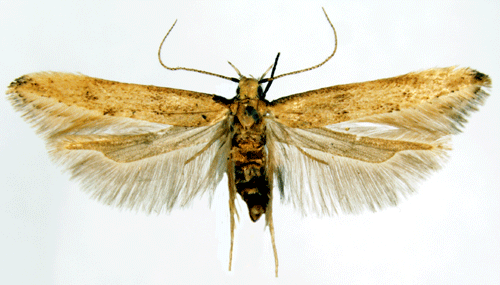




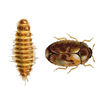

















_001.jpg)
 Case Bearing Clothes Moth
Case Bearing Clothes Moth 

























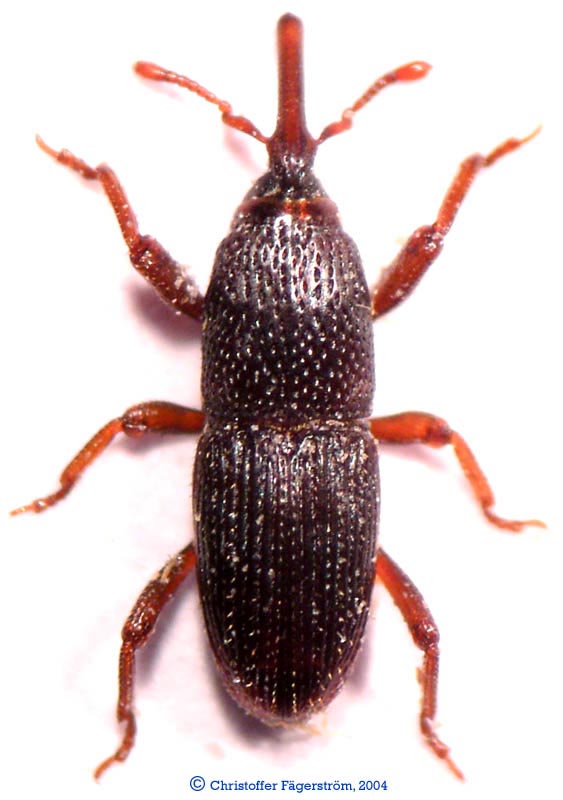











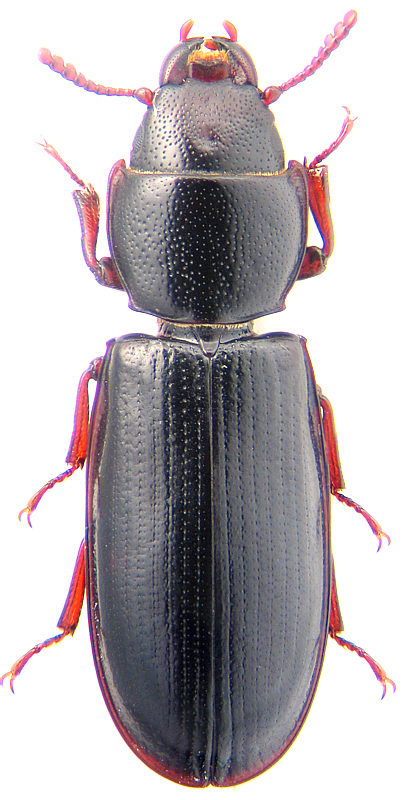



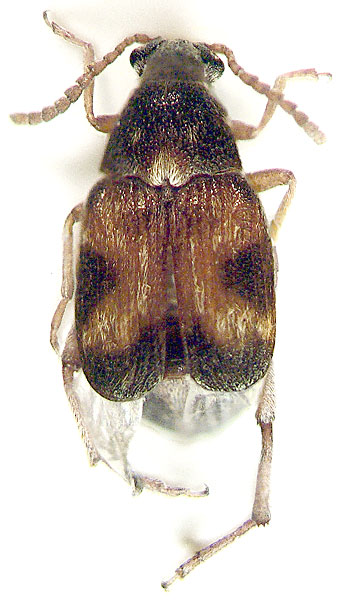



 این وبلاگ توسط دکترای سم شناسی دانشگاه تهران نوشته می شود. استفاده از مطالب وبلاگ با ذکر منبع آزاد است.
این وبلاگ توسط دکترای سم شناسی دانشگاه تهران نوشته می شود. استفاده از مطالب وبلاگ با ذکر منبع آزاد است.